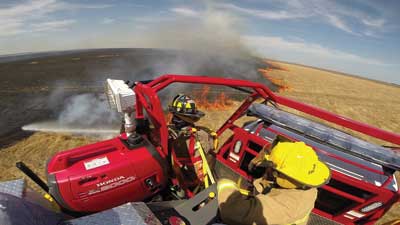
 |
| 1 One tactic for fighting fine-fuels fires involves a firefighter riding on the apparatus exterior aiming a water stream directly at the base of the fire. Apparatus used for this tactic typically include a platform behind the cab where a firefighter can stand. (Photo courtesy of Blanchat Mfg. Inc.) |
By Roger Lackore
Every three to five years, the National Fire Protection Association (NFPA) Apparatus Committee considers revisions to NFPA 1906, Standard for Wildland Fire Apparatus. This document sets minimum standards for the design of apparatus intended mainly for fighting wildland fires.
The Fire Apparatus Manufacturers’ Association (FAMA) participates in this process with one representative on the committee and several more representatives from FAMA member companies.
Differing Tactics
A major challenge to setting wildland apparatus design standards is the tremendously varied environments where wildfires can occur. The tactics used in sparsely populated mountainous regions may be very different from those used in flat forest lands and different again in the fine-fuels areas of the plains states. As with most things in life, the one-size-fits-all approach is likely to be a compromise that leaves nobody happy.
One example of this is a tactic that departments in fine-fuels regions employ where a firefighter rides on the apparatus exterior while it is in motion. The apparatus drives along the fire line and a firefighter aims a water stream directly at the base of the fire. Usually a second or third apparatus follows to mop up. Departments that employ this tactic argue that it is both a safe and essential method where the terrain is flat, the fuel is fine, and the fire line moves quickly. In some cases, such fires can be allowed to burn out on their own; in other cases, they may threaten populated areas.
Fine-Fuels Apparatus Design
Apparatus used for this tactic typically include a platform behind the cab where a firefighter can sit or stand and manually direct a water stream. These apparatus may be offered by smaller apparatus manufacturers or created by modifying existing apparatus. Military surplus vehicles are favorite starting points for some departments. The lack of any design guidance has left no assurance that departments are meeting minimum safety standards or that a vehicle’s size or tank capacity makes it appropriate for traveling on uneven terrain.
For decades, the NFPA approach has been to simply prohibit riding on an apparatus unless all occupants are in a seated and belted position inside an enclosed cab. Both NFPA design standards and NFPA health and safety standards emphasize this. As such, departments convinced that the external riding method is necessary have been purchasing or creating their own apparatus that fall outside of NFPA standards.
Incorporating the Tactic
The NFPA 1906 committee exhaustively discussed the merits and hazards of this approach. There was no argument that the safest place for a firefighter is in a seated and belted position inside an enclosed cab, but given the fact that the practice is so prevalent in certain regions, the committee’s consensus was that it needed to do something. The compromise was to provide an apparatus specification that would increase the safety of an already established practice rather than continue to leave the safety of the apparatus to the judgment of individual departments and manufacturers.
The result will be a new NFPA 1906 option for an onboard pump-and-roll riding position. This option will include a seated and belted position behind the cab, gates to keep the operator within the confines of the apparatus, and a structure to help protect the operator in the event of a rollover. Also included will be a means of communicating with the driver and a prohibition against driving more than 10 miles per hour with the position occupied. If the current direction stays on track, the new option will be included in the next NFPA 1906 revision that will take effect for apparatus contracted for after January 1, 2016.
Please note that these changes to NFPA 1906 are not the end of the story. NFPA 1500 still requires operators to be seated and belted in an enclosed position. Although any changes to that standard will require agreement from the committee, FAMA is participating in the revision process to make sure that the two documents are consistent.
We at FAMA are dedicated to our customers’ safety and as such are active participants in the safety standards process. The NFPA consensus standards process ensures that there is a membership balance to consider all aspects of an issue. Although most FAMA companies include many team members with extensive firefighting experience, we are grateful to our customers and friends whose guidance helps us keep our products both safe and effective. Watch for future FAMA Forum articles that will explore more NFPA apparatus standard changes coming up.
FAMA is committed to the manufacture and sale of safe, efficient emergency response vehicles and equipment. FAMA urges fire departments to evaluate the full range of safety features offered by its member companies.
ROGER LACKORE is the director of product safety for Oshkosh Corporation. He has a bachelor of science degree in mechanical engineering and a master’s degree in engineering management. He is licensed as a professional engineer and a certified safety professional. Lackore has 27 years of design experience in the heavy vehicle industry.

